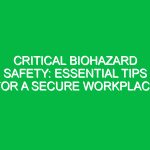Understanding Chemical Hazards in the HSE Context
Chemical hazards are substances that pose a risk to health, safety, and the environment (HSE) through their physical, chemical, or toxicological properties. In workplaces where chemicals are stored, used, or disposed of, recognizing and managing these hazards is critical. From manufacturing plants to laboratories, the potential for chemical exposure can lead to serious health issues, accidents, and environmental damage. Thus, understanding chemical hazards is not only a regulatory requirement but also a fundamental aspect of creating a safe work environment.
This article will delve deeply into chemical hazards, exploring their types, risks, regulatory frameworks, and best practices for mitigation. By understanding these elements, organizations can foster a culture of safety and compliance, ultimately protecting their workforce and the environment.
Types of Chemical Hazards
Chemical hazards can be categorized into several types, each with unique characteristics and risks. Understanding these categories aids in effective hazard management.
1. Toxic Chemicals
Toxic chemicals can cause adverse health effects, including acute or chronic illnesses. Exposure can occur through inhalation, skin contact, or ingestion. The severity of the effects varies based on the chemical’s toxicity level. For instance, substances like lead and mercury are highly toxic and can lead to serious health complications.
2. Flammable Chemicals
Flammable chemicals can ignite easily and pose fire or explosion risks. Common examples include gasoline, solvents, and some gases. The flashpoint—the lowest temperature at which vapors can ignite—determines a substance’s flammability. Proper storage and handling protocols are vital to mitigate these risks.
3. Corrosive Chemicals
Corrosive chemicals can damage or destroy living tissue and materials upon contact. Acids and bases are typical examples. These substances require careful handling to prevent burns or injuries. The use of personal protective equipment (PPE) is essential when working with corrosive substances.
4. Reactive Chemicals
Reactive chemicals can undergo violent reactions when exposed to heat, pressure, or other substances. Examples include peroxides and certain metal powders. Understanding their reactivity is crucial for safe storage and handling, as mishandling can lead to explosions or toxic gas release.
The Risks Associated with Chemical Hazards
Chemical hazards in the workplace present various risks that can affect workers, the environment, and the organization as a whole. Here are some critical risks to consider:
1. Health Risks
Exposure to chemical hazards can lead to immediate or long-term health issues, including respiratory problems, skin diseases, or even cancer. For example, workers who handle asbestos without proper precautions may develop mesothelioma, a serious lung condition.
2. Environmental Risks
Chemical spills and leaks can have devastating effects on the environment. Contaminated water sources, soil degradation, and harm to wildlife are just a few potential consequences. The 1986 Chernobyl disaster serves as a stark reminder of the environmental impact of chemical hazards when safety protocols are neglected.
3. Financial Risks
Organizations may face significant financial repercussions due to chemical hazards. This includes costs related to worker compensation, legal liabilities, and fines for regulatory non-compliance. Additionally, accidents can lead to operational downtime, further affecting profitability.
Best Practices for Managing Chemical Hazards
To ensure a safer workplace, organizations must implement effective practices for managing chemical hazards. Here are some best practices to consider:
1. Conduct Regular Risk Assessments
Regular risk assessments help identify potential chemical hazards and evaluate the risks associated with them. This proactive approach allows organizations to implement necessary controls before incidents occur. Risk assessments should consider the nature of the chemical, its quantity, and the work processes involved.
2. Proper Labeling and Signage
All chemicals should be clearly labeled with information regarding their hazards, handling instructions, and emergency measures. This includes using standardized symbols and signage to alert workers about potential risks. Labeling not only aids in compliance but also enhances safety awareness among employees.
3. Provide Training and Education
Training employees on the proper handling and storage of chemicals is essential. Workers should understand how to read Safety Data Sheets (SDS), recognize chemical hazards, and respond to emergencies. Regular training sessions can reinforce knowledge and ensure that safety practices remain fresh in employees’ minds.
4. Use Personal Protective Equipment (PPE)
PPE is a crucial line of defense against chemical hazards. Employers should provide appropriate PPE such as gloves, goggles, and respirators based on the specific risks involved. Regular inspections and maintenance of PPE ensure its effectiveness and compliance with safety standards.
5. Implement Emergency Response Plans
A comprehensive emergency response plan is vital for addressing chemical spills, leaks, or other incidents. This plan should outline evacuation procedures, communication protocols, and first aid measures. Conducting regular drills ensures that employees are prepared to respond swiftly and effectively in an emergency.
Regulations and Standards Governing Chemical Hazards
Understanding the regulatory landscape surrounding chemical hazards is crucial for compliance and safety. Various international and national standards govern the use and management of hazardous chemicals in the workplace.
1. Occupational Safety and Health Administration (OSHA)
In the United States, OSHA sets and enforces standards to ensure safe and healthful working conditions. OSHA‘s Hazard Communication Standard (HCS) requires employers to inform employees about the hazards of chemicals through labels and safety data sheets. Compliance with HCS not only protects workers but also reduces the likelihood of workplace accidents.
2. Globally Harmonized System (GHS)
The GHS aims to standardize the classification and labeling of chemicals internationally. It provides a framework for consistent hazard communication, making it easier for organizations to communicate risks across borders. Adopting GHS can enhance safety and compliance in global operations.
3. Environmental Protection Agency (EPA)
The EPA regulates hazardous waste management and chemical disposal. Organizations must comply with the Resource Conservation and Recovery Act (RCRA), which governs the management of hazardous waste from its creation to disposal. Non-compliance with EPA regulations can lead to severe penalties and environmental harm.
Real-Life Examples and Case Studies
To further illustrate the importance of understanding chemical hazards, consider the following scenarios:
Case Study: The Bhopal Disaster
In 1984, one of the worst industrial disasters in history occurred in Bhopal, India, when a gas leak from a pesticide plant exposed thousands to methyl isocyanate. The tragedy resulted in thousands of deaths and long-term health issues for survivors. This incident underscores the catastrophic consequences of neglecting chemical hazards and the importance of robust safety protocols.
Industry Insights: Chemical Manufacturing
In the chemical manufacturing sector, companies like BASF have implemented comprehensive safety programs that include regular audits, employee training, and emergency response drills. By prioritizing safety, these organizations not only protect their workforce but also enhance productivity and reputation.
Conclusion
Chemical hazards are an integral aspect of workplace safety, and understanding them is vital for protecting employees and the environment. By recognizing the types of chemical hazards, assessing risks, and implementing best practices, organizations can create safer work environments. Compliance with regulatory standards further enhances safety and fosters a culture of responsibility.
As we continue to navigate the complexities of workplace safety, it is essential to remain vigilant and proactive in managing chemical hazards. Organizations must prioritize training, invest in safety measures, and cultivate an atmosphere where safety is a shared responsibility. By doing so, we can work towards a safer, healthier, and more sustainable future for all.


